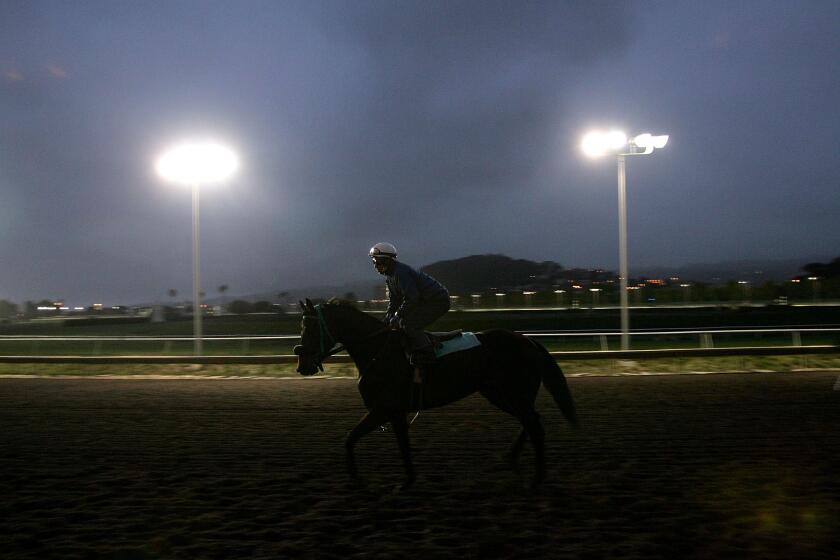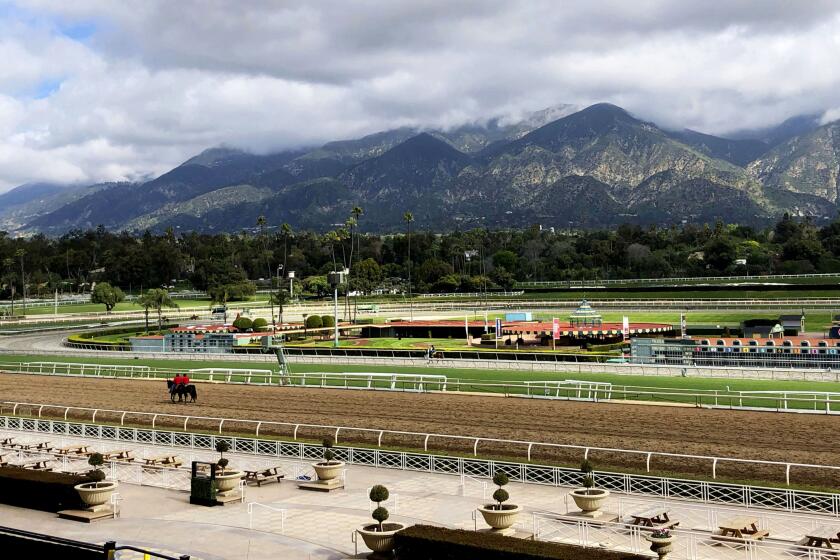Attempt to revive horse racing in Northern California ends, affecting the sport around the state

- Share via
The grand experiment to revive horse racing in Northern California is coming to an end. On Monday, the board of the California Assn. of Racing Fairs voted unanimously, 6-0, to withdraw its application for a racing meeting from Dec. 25 to June 10 at Pleasanton Fairgrounds Racetrack.
The deadline for a decision was Thursday, when the California Horse Racing Board had two items on the agenda about racing at Pleasanton. Now those items will be withdrawn.
The decision was first reported by The Times.
The formation of Golden State Racing, under the umbrella of CARF, was an effort to keep near-full-time racing in Northern California after the Stronach Group announced and subsequently closed Golden Gate Fields. It left a void in the state for a place where horses not of the quality of Santa Anita and Del Mar could run.
After 83 years, Sunday is the last day of racing at Golden Gate Fields. The track will be missed for its inclusiveness and place in California racing history.
This will no doubt have an impact not only on the horsemen in Northern California but also a state breeding industry that will have little reason to extensively breed if there is no place to run the horses. More than a third of the races at Golden Gate Fields were restricted to California-bred horses.
The decision is not currently expected to affect the summer fair circuit of races, but, of course, it will need horses to run those races to succeed. If many of the trainers and horsemen decide to go elsewhere, or retire from the business, it could endanger the fairs.
The move is not unexpected as the racing circuit’s initial foray into fall/winter racing was met with a mutuel handle less than expected and subsequently led to two purse cuts. The 26-day meeting started Oct. 19 and will end Wednesday.
The handle at GSR was 62% lower than Golden Gate and the national market share of wagering slipped from 5% at Golden Gate to 2.1% at GSR.
Purses at GSR were about 30% less than at Golden Gate.
Another disadvantage of Pleasanton is that it didn’t have a turf course; about half the racing in the south was on grass.
The Stronach Group, the owner of Santa Anita and operating under the moniker of 1/ST Racing, has a proposal to help alleviate the effect on Northern California horsemen. It has offered to fund off-season stabling at Pleasanton and to write races that better fit the makeup of Northern California horses. The proposal would also help pay for the cost of vanning horses and relocation expenses for horsemen, including grooms and trainers. It would allow trainers to work their horses at Pleasanton and van south for races.
The closure of Golden Gate Fields is just one problem California horse racing faces. Non-competitive purses and a sinking foal crop paint a tough picture.
There may also be a home for some of the horses at Los Alamitos, which had trouble filling fields during its six-day winter thoroughbred meeting, which concluded Sunday. It also runs thoroughbreds at 4 ½ furlongs at night.
This all comes after the Stronach Group, in conjunction with the Thoroughbred Owners of California, hatched the plan to kill off racing in the north in order to help save the south.
“I’m proud that industry stakeholders have united to forge a sustainable future for California racing,” Aidan Butler, chief executive of 1/ST Racing, said in a statement. “This agreement ensures stability for racing and training across the state while strengthening the overall product we present to fans and participants.”
Bill Nader, chief executive of the Thoroughbred Owners of California, echoed the optimism.
“This blueprint represents the most efficient use of resources, building a stronger foundation at Santa Anita while addressing the unique needs of our constituents in Northern California,” Nader said in a statement. “Utilizing Pleasanton as an off-site stabling and training hubs ensures continuity for horses and staff.”
The thinking is that simulcast revenue that would normally go to the north would be redirected to the south. Last year, Santa Anita had a $6-million shortfall on purses that was covered by the track. The TOC is responsible for the purses, and it is not unusual for the track to cover any shortage, counterintuitively called an “overpayment.”
This alone will only marginally improve the position of racing in Southern California as it needs another form of supplemental income, such as historical horse racing, to compete on the national racing landscape.
More to Read
Go beyond the scoreboard
Get the latest on L.A.'s teams in the daily Sports Report newsletter.
You may occasionally receive promotional content from the Los Angeles Times.











